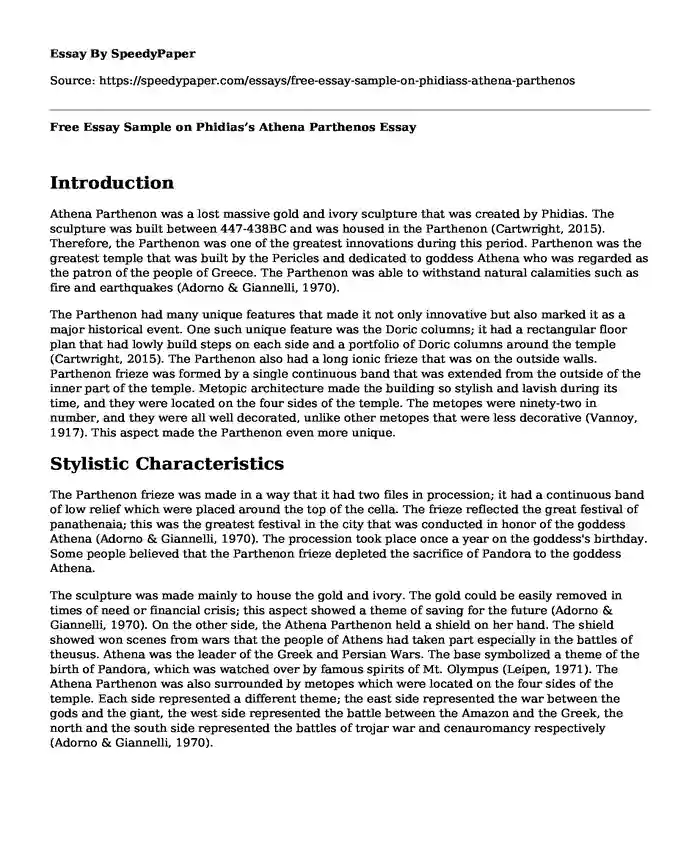
| Type of paper: | Essay |
| Categories: | Architecture Ancient Greece |
| Pages: | 3 |
| Wordcount: | 641 words |
Introduction
Athena Parthenon was a lost massive gold and ivory sculpture that was created by Phidias. The sculpture was built between 447-438BC and was housed in the Parthenon (Cartwright, 2015). Therefore, the Parthenon was one of the greatest innovations during this period. Parthenon was the greatest temple that was built by the Pericles and dedicated to goddess Athena who was regarded as the patron of the people of Greece. The Parthenon was able to withstand natural calamities such as fire and earthquakes (Adorno & Giannelli, 1970).
The Parthenon had many unique features that made it not only innovative but also marked it as a major historical event. One such unique feature was the Doric columns; it had a rectangular floor plan that had lowly build steps on each side and a portfolio of Doric columns around the temple (Cartwright, 2015). The Parthenon also had a long ionic frieze that was on the outside walls. Parthenon frieze was formed by a single continuous band that was extended from the outside of the inner part of the temple. Metopic architecture made the building so stylish and lavish during its time, and they were located on the four sides of the temple. The metopes were ninety-two in number, and they were all well decorated, unlike other metopes that were less decorative (Vannoy, 1917). This aspect made the Parthenon even more unique.
Stylistic Characteristics
The Parthenon frieze was made in a way that it had two files in procession; it had a continuous band of low relief which were placed around the top of the cella. The frieze reflected the great festival of panathenaia; this was the greatest festival in the city that was conducted in honor of the goddess Athena (Adorno & Giannelli, 1970). The procession took place once a year on the goddess's birthday. Some people believed that the Parthenon frieze depleted the sacrifice of Pandora to the goddess Athena.
The sculpture was made mainly to house the gold and ivory. The gold could be easily removed in times of need or financial crisis; this aspect showed a theme of saving for the future (Adorno & Giannelli, 1970). On the other side, the Athena Parthenon held a shield on her hand. The shield showed won scenes from wars that the people of Athens had taken part especially in the battles of theusus. Athena was the leader of the Greek and Persian Wars. The base symbolized a theme of the birth of Pandora, which was watched over by famous spirits of Mt. Olympus (Leipen, 1971). The Athena Parthenon was also surrounded by metopes which were located on the four sides of the temple. Each side represented a different theme; the east side represented the war between the gods and the giant, the west side represented the battle between the Amazon and the Greek, the north and the south side represented the battles of trojar war and cenauromancy respectively (Adorno & Giannelli, 1970).
Conclusion
Phidias's work on the Athena Parthenon had many contributions to humanities. It acted as a symbol of Athenian and Greek culture, and it had a religious significance (Adorno & Giannelli, 1970). Athena Parthenon also symbolized wealth since a lot of money was used in building the sculpture, which portrayed Athena as being wealthy to the rest of the world (Vannoy, 1917). Phidias's artistic work also made Athens powerful both literally and artistically. Therefore, displaying Athens as the most successful country as it was also the leader of the Greek and Persian Wars. It also made Athens famous as it represented its wisdom and innovation.
References
Adorno, F., & Giannelli, G. (1970). The World of classical Athens. New York: Putnam.
Cartwright, M. (2015, January 25). Athena Parthenos by Phidias. Ancient History Encyclopedia. Retrieved from https://www.ancient.eu/article/785/
Leipen, N. (1971). Athena Parthenos: A reconstruction. Toronto: Royal Ontario Museum.
Vannoy, C. A. (1917). Studies on the Athena Parthenos of Pheidias. Iowa City: The Universityof Iowa.
Cite this page
Free Essay Sample on Phidias's Athena Parthenos. (2023, Nov 09). Retrieved from https://speedypaper.com/essays/free-essay-sample-on-phidiass-athena-parthenos
Request Removal
If you are the original author of this essay and no longer wish to have it published on the SpeedyPaper website, please click below to request its removal:
- Renewable Energy Essay Example
- Andrew Jackson Message vs. Michael Routledge Message, Free Essay
- Essay Sample: Nonverbal Communication in Native American's Culture
- Essay Sample on the Top Censored Stories of 2007 and 2008: Violation of Local and Foreign Human Rights
- Essay Example on Florida's Demographics
- Essay Sample on City Planning and Tourism
- Article Analysis Essay on Incumbency, National Conditions, and the 2012 Presidential Election
Popular categories




